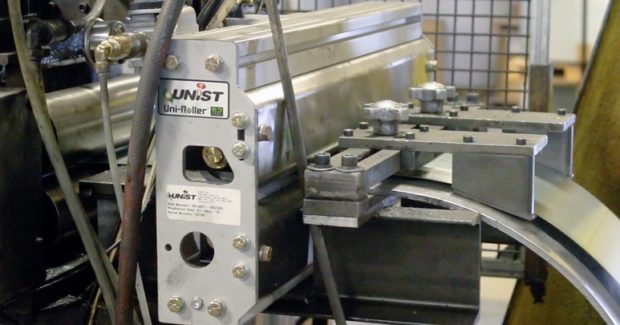How to Defeat Downtime
No one is happy when a machine goes down because of tooling issues – wasted time that is even more frustrating when it’s avoidable. Arrow Storage Products found a way to significantly reduce their machine downtime and cut their average tooling downtime per week due to tooling by 70 percent.
Posted: September 22, 2018
Arrow Storage Products (Breese, IL) is a division of ShelterLogic Group (Watertown, CT), which has delivered reliable and tough shade, shelter and storage systems to direct customers and retail partners for over 50 years: if you have rested in the shade of or protected equipment with shelters from ShelterLogic, Arrow Storage Products or Quik Shade, then you have enjoyed the use of some of their equipment. Inside the Arrow shop, a Niagara press punches over 30 holes through an 8.125 in wide coil, which then moves to a roll former to profile the final shape. Tim Farina, a manufacturing engineer at Arrow, saw that the punches were sticking down and catching on the coil – a tooling problem probably related to lubrication. Using the correct lubricant is important to help avoid sticking or galling. No matter how good the lubricant is, and no matter how well suited it is to the application, if the right amount isn’t applied in the right place, it won’t do any good.
The performance of even the best lubricant is no better than the system that applies it. Arrow was determined to improve their processes and suspected that one way to do this was to replace their home-built spray application system. With spraying, it can be hard to achieve a consistent coating since spray heads rarely have a perfectly even spray pattern. Spraying is also often quite messy, especially when trying to coat the bottom of the coil. Overspray goes in places it is not wanted, such as machines, floors, and into employees’ lungs. Arrow was experiencing these issues and needed a system that could precisely apply the right amount of oil on the coil. After doing research, Farina decided on a roller-based system, the Uni-Roller® S2 from Unist, Inc. (Grand Rapids, MI). Inside each roller is a dispenser tube with small holes placed along its length that distributes the fluid evenly across the width of the roller. Fluid is injected into the dispenser tubes using a SPR-2000™ fluid controller and distributed across the inside of the roller covers.
The lubricant is transferred to the stock through durable, polyester felt roller covers. The amount of fluid added to the inside of the cover is precisely the same as what is applied to the stock on a roller rotation to keep the amount of fluid consistent over time, regardless of press speed. The design and materials used in the roller covers guarantees that fluid from the dispenser tubes is evenly distributed across the entire roll to maintain consistent coverage. Farina also wanted a robust system and liked how the Uni-Roller S2 is constructed with powder-coated steel endplates and heavy duty, custom aluminum extrusions, with brushed stainless steel guards that protect the rollers and help guide material when loading the coil. He also liked how standard preventive maintenance is simple: with the guards removed for better access, a roller can be changed in about a minute using a single wrench.
The applicator is half of the solution. Controlling the fluid itself is the other half, which is where the SPR-2000 electronic controller enters the picture. It calculates the amount of fluid needed based on press speed, then uses a bank of valves to dispense the required fluid to the appropriate rollers. The programmable actuation of the valves is based on an intermittent (rate dependent) input from the line. On stamping presses, this input is typically based on the stroke of the press and comes from a programmable limit switch (PLS) or the press controller. In continuous speed operations, such as the roll forming done at Arrow, a rotation sensor detects the roller rotation. The SPR-2000 can save up to 250 setups, which means changing to a new job is as simple as pushing a few buttons. The robustness of this system also extends beyond the physical toughness of the applicator. The SPR-2000 can also monitor critical parameters, such as fluid level, fluid pressure, and flow, and alert the operator with an audible alarm, a red LED, or an external alarm relay wired directly to a press control. If unauthorized access to the system settings is a concern, the system can be configured with a custom four-digit access code that allows the operator to monitor alarms and recall saved setups, but not modify system settings or create new setups.
When Farina moved to this Unist system, the shop achieved better control of their fluid application and saw their average tooling downtime per week due to tooling drop by 70 percent – these savings alone allowed the new system to pay for itself. The shop also saw the other advantages that go with precision fluid application: reduced fluid consumption and the elimination of spray and all the negative health and safety ramifications associated with it. Arrow started implementing more Unist S2 units on other presses and hopes to outfit most of them as budgets allow. “We definitely like what we are seeing,” said Farina. “The improvement in downtime has been very rewarding for everyone involved.”


















